Variants of a gene which influences connections between brain cells can increase schizophrenia risk, scientists said Wednesday, providing the first evidence of a physiological source for the debilitating disorder.
The findings may allow future treatments to be directed at the root of the affliction rather than at its symptoms, said the authors of a study published in the journal Nature.
Based on genetic analysis of some 700 deceased people and nearly 65,000 living ones, about half of them with schizophrenia, researchers found that sufferers had specific variants of a gene called complement component 4, or C4 for short.
Mouse studies then implicated the gene in a brain process called "synaptic pruning".
Synapses are connections between brain cells, or neurons.
Occasional pruning is needed to remove rarely-used synapses to increase efficiency of the entire network -- a process that typically begins during adolescence.
Excessive pruning, though, can cause problems.
"The findings may help explain the longstanding mystery of why brains from people with schizophrenia tend to have a thinner cerebral cortex with fewer synapses than unaffected individuals do," said a press statement from the Broad Institute of MIT and Harvard, whose experts took part in the study.
This is the brain's outer layer, often referred to as grey matter, involved in learning and memory.
"The work may also help to explain why the onset of schizophrenia symptoms tends to occur in late adolescence," it said.
"The human brain normally undergoes widespread synapse pruning during adolescence, especially in the cerebral cortex.
- 'Crucial turning point' -
"Excessive synaptic pruning during adolescence and early adulthood, due to increased complement (C4) activity, could lead to the cognitive symptoms seen in schizophrenia."
The authors said their paper was the first to provide genetic evidence of a long suspected link between schizophrenia and excessive synapse pruning.
The devastating psychological disorder affects more than 20 million people in the world, and is characterised by hallucinations, delusions, paranoia and a breakdown of thought processes.
Symptoms typically start between the ages of 15 and 35.
There is no cure, and treatment of the symptoms have limited effect.
"This study marks a crucial turning point in the fight against mental illness," commented Bruce Cuthbert, acting director of the US National Institute of Mental Health.
"Because the molecular origins of psychiatric diseases are little-understood, efforts by pharmaceutical companies to pursue new therapeutics are few and far between. This study changes the game. Thanks to this genetic breakthrough we can finally see the potential for clinical tests, early detection, new treatments, and even prevention."
The work could pave the way, for example, for drugs that inhibit synaptic pruning in people with early symptoms of schizophrenia, said the statement.
In comments to the Science Media Centre in London, Judith Pratt of the Strathclyde Institute of Pharmacy and Biomedical Sciences said the study was an important step in schizophrenia research. But there were caveats.
Mice like the ones used in part of the study did not have the same forms of C4 as humans do. It thus remains to be shown that impaired synapse pruning actually occurs in people with schizophrenia.
Also on HuffPost





